In the year setting the lowest finish-rate for Tuscobia Winter Ultra’s signature 150-mile run, Scott Hoberg tamed the trail tundra in a blazing record 44:44. This mark shines more amazing when considering the added mileage with the start now in Rice Lake, WI. From the start at the perfectly suited Knights of Columbus Hall (KOC) along the Wild Rivers State Trail, athletes traveled northbound for 3.5 miles. Turning right, crossing Hwy SS, these snow runners entered the Tuscobia Trail for an enchanting—and spellbinding—74 miles of journey to Park Falls . . . then back.
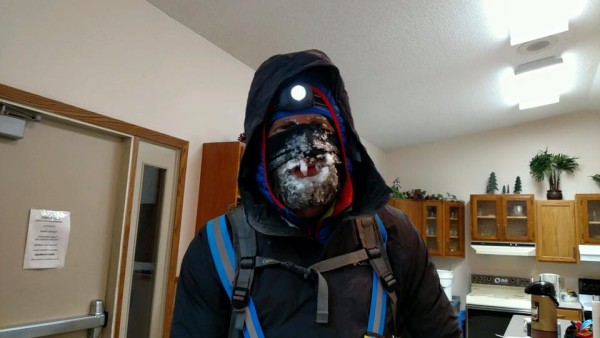
Scott Hoberg, just after winning the Tuscobia 150 on foot, inside the KOC race headquarters
Leaving with 22 determined winter-endurance athletes on a mild snowy Friday morning, January 8, 2016, 6:10 a.m., Duluth, Minnesota’s star led the field by four hours at the first checkpoint, Ojibwa. Minneapolis’ Edward Sandor who tied fourth in 2015 (with Dominique LaSalle, St. Paul), quipped, “I learned a few things. Scott Hoberg was just toying with Grant Maughan and me for the first 30 miles of shared trail-breaking duty. He decided to go at 36 miles (about six miles west of Couderay), and the next time I saw him, he was 11 miles and a 45-minute break ahead of me.”
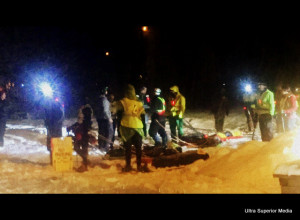
Milling about three minutes before the 6:10 a.m. start of the 150 run
Hoberg revealed a secret to that change: “The night before the race Park Falls had two or three inches of fresh snow. That meant breaking-trail duties for the lead group . . . until a snowmobile came through” leaving a packed path where he could use his speed.
Mild and snowy morphed to bitter and blowy, the cold front pushing behind the cloud cover, taking charge. Warm-hearted at the start, Tuscobia revealed its frigid face as competitor after competitor fell to its numbing offering. Extreme cold hurts; only a quartet would ultimately complete the entire 150 miles on foot.
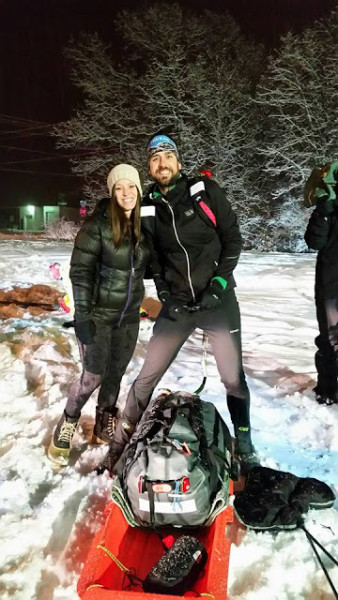
Edward Sandor gamely made 105 miles before the leg gave out. “I told myself ‘I can do this’ a billion times, and I believed it for a while, but the pain kept building. Every few steps my leg would move in a way it shouldn’t.” Courtesy Edward Sandor
Hoberg continued, “As the sun was setting the first day, the trail firmed up and stayed that way the rest of the race, which really helped.”
Leaving Ojibwa at 6:05 p.m., Hoberg worked overnight to make the turn in this out-and-back course at Park Fall’s St Anthony of Padua School and Church. That time, 3:45 a.m. Saturday morning; in the books . . . 80 miles, half-done, under 22 hours. Somehow it seemed St. Anthony of Padua himself felt athletes required a tougher journey in the style of his taken over monstrous seas centuries earlier . . . and that is exactly what they got, except on snow while pulling a smaller vessel, a pulk. Competitors on foot pull this sled filled with required survival gear, food and clothing weighing nearly 30-40 lbs for the entire distance. It fills the role of a nomadic home-away-from-home.
Marcus Steele, Depere, 2015 winner of the 75 mile bike race, offered this account best describing the travails of starting in nice temperatures, then having them plummet like a high dive off a Hawaiian cliff.
He explained the chain that jammed, then a flat-tire from an icy pothole setting off a string of travails. “By now I was a bit frustrated but Christen (his wife) calmed me down.” At Park Falls one of many possible but improbable challenges an athlete may suffer occurred, “the big mishap, which was ultimately my demise. My Camelbak tube popped off and got my jacket and the backpack nearly saturated. I tried to dry them” but that does little good. So off he goes, driving to get a finish.
The quicksilver continued plunging. “The problem was if I got warm the [now frozen] jacket and backpack [melted and] got me wet again and more chilled. So I tried to pace a bit slower to keep the jacket frozen.”
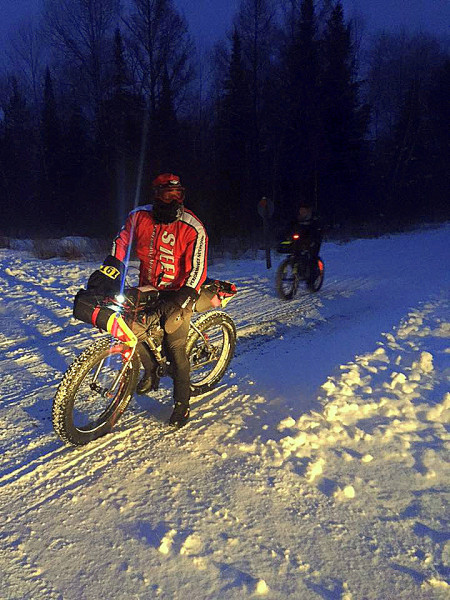
Marcus Steele’s story reads like a primer for winter survival
The backpack became a block of ice on my back, and I got rather chilled by 110 miles.” After stopping by a convenience store for a warm-up, he makes another 20 miles “then the bottom fell out. After 18 hours of biking and ending temp of minus 12, a wind-chill of minus 28, 137 miles and now severe shaking and cold, I had to pull the plug . . . the hands and feet would not work any longer. It made balancing the bike impossible.”
“Thankful for my emergency bivy, spot-trackers and the fact that Christen made a good call and came and found me herself. This was very scary for me and her. I learned a lot but need to respect mother nature.” So after recovering and warming up some hours later, his verdict? As great adventurers would say, “I will be back to conquer this bad boy.”
He’s now in recovery mode for the Arrowhead 135 starting January 24, 2016.

Pre-Race meeting hosted by RDs Helen and Chris Scotch plays to a full house at the KOC hall. That is Josh Weigel in the foreground with red jacket finished the 75-bike in 10:19.
If one wonders how Tuscobia Trail ultimately culled its finish list, variations of Steele’s report abounded. The trail rose queen-like showing why these miles of winter beauty and historical incantation mysteriously beat contenders into submission.
Many looked like the closing scenes in Stanley Kubrick’s movie “The Shining.” Jack Nicholson froze when unable to escape the hotel’s frozen hedge maze, his face glaring blankly through an icy mask. Just finishing, or perhaps winning an award on the wonder known as Tuscobia Trail, means the competitor successfully managed its maze. That defines the draw to the Tuscobia Winter Ultras: a real-time puzzle set in difficult circumstances. Suffering to secure a finish stirs a tonic gulped each mile counted down, making progress; then every tenth of a mile, finally clicking of large trees, fence posts, whatever, to suddenly lights, applause, curtain . . . exit stage right to the KOC. A finish feels like, as actor Charlie Sheen exclaimed, “Winning!”
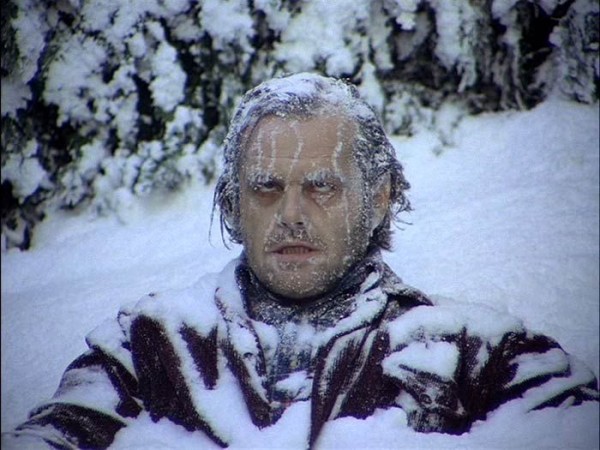
The Shining’s Jack Nicholson frozen like an ultra winter athlete
Hoberg headed back on his return lap while temperatures readied their plunge into minus territory after remaining winter-mild to this point. Tuscobia begins collecting its due one-by-one as the landscape watches Hoberg pass heading to Rice Lake.
He explains, “The hardest section of the race was definitely the last few miles of the Tuscobia trail from Brill to the Wild Rivers trail.” That area, about halfway between Birchwood and the Tuscobia Trail terminus, breaks out of the forest into a stretch of open area meaning the cold wind smacks without any protecting barrier. Then the mind begins talking . . . “You know you are so close to the finish line, but yet it’s still a couple of hours away; that mixed with it being the middle of the second night, and no sleep, made things tough.”
By the time of his record, 2:54 a.m. Sunday morning, lows in the minus teens swept along with a northwest wind dotted the terrain, slapping racers after the Park Rapids turn full-on in the face. Nevertheless, they head back. The weather map even placed a big red arrow over the state of Wisconsin with bold letters shouting “BRUTAL COLD.”
In 2014 Hoberg captured the granddaddy of winter ultras, the Arrowhead 135 overall win so his record at Tuscobia doesn’t ring “surprise.” Arrowhead tallies significant miles less than Tuscobia, but the trail’s unique challenges make up for that. He added the Western States 100 finish, the kingpin of trail races held in Squaw Valley, CA., to his 2014 totals. Finishing Leadville’s 100 and The Race Across The Sky in 2013, along with winning the Superior Fall 100 Mile race in 2015, pares an impressive résumé.
As Hoberg warmed at the KOC, only three 150 runners remained on the course.
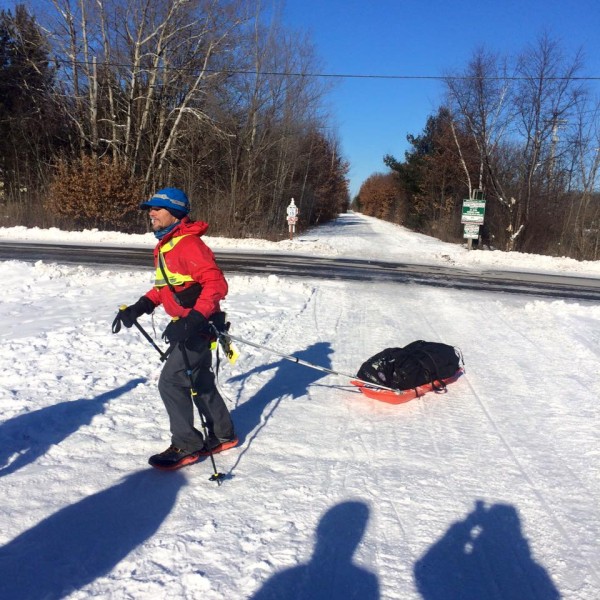
Grant Maughn at the KOC finish, Rice Lake. Photo courtesy Scott W Kummer
Grant Maughan, AUS., claimed silver ten hours later (54:09). Maughan’s background demonstrates a global prowess at ultra distances. Ranking finishes at the Ultra-Trail Du Mont-Blanc 170 km, he also raced this past Fall in Chamonix, FRA—“Seven valleys, 71 glaciers, 400 summits”—along with placing ninth at Death Valley’s 2015 epic Badwater. He completed the Andorra Ultra Trail – Ronda Dels Cims, one of the world’s hardest 100 miles, run over mountains of steep rock offered by this tiny tax-haven principality situated between France and Spain. Maughan now can count the silver Tuscobia Winter Ultra finish among his best.
The man who never quits, John Taylor, Minneapolis, MN, continued that mantra by using the clock to his advantage. His 73 minutes at the St Anthony of Padua School turnaround during the noon hour on Saturday gave him the recovery required to repeat the course back to Rice Lake in another 33 hours. His race totaled 64:08, revealing he only required roughly three more hours than the first half even though conditions offered a far less pleasant journey.
![Tuscobia Winter Ultra Tuscobia races ended when these two [John Taylor (r) and Thomas Keene] crossed the finish in the race's final hour](https://www.snowshoemag.com/wp-content/blogs.dir/5/files/Tuscobia-150-2016-John-Taylor-Tom-Keene-2-last-finishers-courtesy-Tuswintultra-600x600.jpg)
Tuscobia races ended when these two [John Taylor (r) and Thomas Keene] crossed the finish in the race’s final hour
With a background of 100-mile finishes along with Arrowhead’s 135, Thomas Keene, Hendersonville, TN, gallantly marched on. Earlier he led Taylor until registering ten minutes back at Park Falls. Keene grabbed his second Tuscobia finish for the Volunteer State by making the line 28 minutes tailing Taylor. He is now one step closer to qualifying for the Order of the Hrimthurs [and Here], an award given those finishing Tuscobia, Arrowhead [Keene, a 2016 entrant], and Actif Epica.
The 150 fat tire field crowded Ojibwa’s checkpoint on the way out after their 6:03 a.m., Saturday-start at KOC. The race reported, “Some speedy times . . . the trail is hard and fast. The 150-mile runners kindly laid down a nice line with their sleds. Group of four or five all together at the front.” Ultimately 29 of the 44 starters earned their finish.
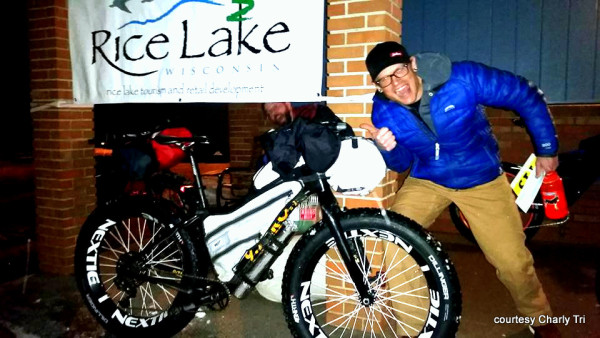
Charly Tri with the hospitable and friendly Rice Lake, WI, welcome sign for all the Tuscobia Winter Ultra competitors
The early leader ran into problems. Charly Tri, Rochester, MN, a perennial competitor and the first checked-in at 10:19 a.m., reported a back problem related to moving the Friday snowfall at his business. “Soon after the first checkpoint, my back started painful spasms. (As those spasms continued) my Tuscobia race . . . done.”
He correctly pointed out that Ben Doom, St. Cloud, MN, and Todd McFadden, Duluth, looked particularly strong at that early stage. McFadden, winner of the 2015 Solon Spring 100K, eventually crossed fourth in 15:50.
In one of the closer finishes at the top, Dan Lockery, Winnipeg, captured the bronze plaque in a time relatively close to Doom’s silver. Lockery, 2015’s silver medalist, noted, “I had lots of fun out there. Great conditions and lots of fun to ride with or near a few people; keeps it interesting.”
Doom said, “We took turns pulling on the Tuscobia, but I was ahead the entire Wild River Trail. It was a bit more spaced out [toward the finish than reported results] but [the race] doesn’t just have timers milling about in sub-zero temps.” In 2015 he notched sixth place, but this year’s 15:47 showed a nearly two-minute improvement per mile.
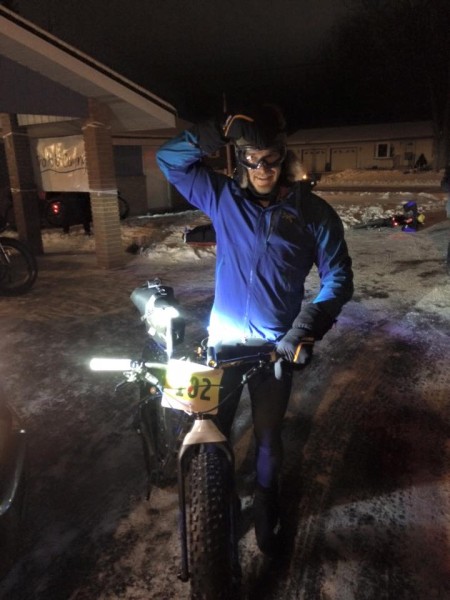
Winner Ryan Atkins before heading to the Saturday morning start of the fat tire 150
Winning the event, Ryan Atkins, Caledon, ON, captured gold some 44 minutes earlier, 9:06 p.m., in 15:03. Completing his first race on a fat tire, Atkins’ time tallied just nine minutes more than recorded by 2015’s winner, Jay Petervary, ID, on the shorter-distance. Out of the Park Falls turnaround in first place by a few minutes, Atkins extended his lead to more than a half-hour heading home from Ojibwa. He never looked back.
Extreme fitness enables him to continue strong in his endeavors. Winning the 2013-2014 World’s Toughest Mudder and other endurance, obstacle-racing events demonstrates his ability. He told me, “The Tuscobia was a cool event for sure. I learned that winter racing is all about paying close attention to your body for any signs of discomfort and trying to fix them before it’s too late. At the same time sometimes you have to push through those discomforts. So having the wisdom to know when to push and when to stop is key. Then it’s pretty much like any other endurance race: Don’t stop, and try to pace yourself.”
Alaska’s Dan Powers took honors in the 150 mile ski class, which kicked off Friday at 11 a.m. From Fairbanks, AK, he completed the course Sunday afternoon in 56:28. Notably he medaled the 2014 Alaska Mountain Wilderness Ski Classic.
For the 75 mile ski version, Dan Campbell, MT, made it in 12:01 by utilizing Nordic ski skills he coached at Montana State University along with those Birkebeiner experiences.
Notably for the 75 mile run, St. Paul’s Faye Norby won the overall in a tough 21:46, knocking 51 minutes off her 2015 class win. That race traveled East-North-East with the prevailing winds at one’s back. This year’s Park Rapids start meant she ran directly into a cold West wind. There are many variables that can account for her time differences, but simply stated she completed the race’s longer distance faster this year on the new direction than last. Josh Thiemann of Dodge Center, MN, took silver less than 30 minutes later while Nathan Marti, Courtland, MN, tied with Duluth’s Dave Schuneman at 22:52 for bronze honors.
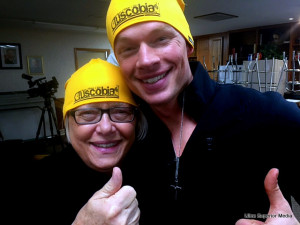
Mary Hilfiker enjoyed her time at the 2016 Tuscobia Winter Ultras shown her with Minneapolis actor Tyler Jensen
Minneapolis’ Kari Gibbons finished as second female in 26:56. Jennifer Flynn, Coon Rapids, MN, and Anjanette Arnold, Dundas, MN, tied the 30:53 mark for the bronze recognition. The 75 mile run completed 56 percent of the 36 starters.
Biking for the 75 class gold, Peter Demos, ON, broke eight hours grabbing the overall winner title. Life revolves around his family plus the business of distribution and development of products, parts and equipment for fat tire bikes. He also produces a line of paddleboards for the Muskoka Lakes paddler.
A dozen minutes later, Ron Williams, Duluth, nailed silver. Fourth in 2015, David Pramann, Burnsville, MN, pushed Williams, finishing just three minutes back securing the bronze spot on the podium.
Andover’s Pam Nielsen won the 75 bike female class for Minnesota and sixth overall. An active athlete with many regional running ultras on the list, she also placed fourth in class at The Heck of the North 108 mile bike race.
Rhonda Wright, NE, edged Duluth’s Ann Sudoh by just a minute to win her silver medal. The class had 33 finishers for a 62 percent finish rate.
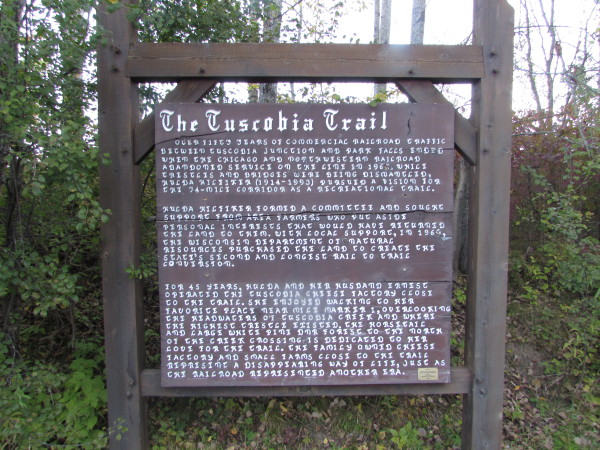
Sign commemorating Hulda Hilfiker’s efforts to create the Tuscobia Trail circa 1968
The race enjoyed a special guest this year: Mary Hilfiker, St. Paul. Her mother, Hulda, along with dad, Ernest, owned the Tuscobia Cheese Factory in Rice Lake. She managed the leg work necessary to secure the abandoned railroad in the late 1960’s for its greatest role as the Tuscobia Trail. Entering the trail’s terminus one finds a large sign commemorating her efforts securing the rights for these 74 miles by farmers who could have elected to recapture their land. About a mile into the trail heading east perches a bench with a small plaque at the site of the old railroad trestle. A separate, larger plaque mounted on a small boulder by the Wisconsin DNR at what would have been the bottom of the trestle’s arc formalizes her work.
The trail from the terminus and trestle found Hulda’s heart. One can see her name in several other places by the trail. Mary recounted tales of playing on the trestle as a girl with other kids, imagining trains racing them to their escape. Some believe at night, when dark and quiet, those trains reinhabit their former glory on the Tuscobia Line.
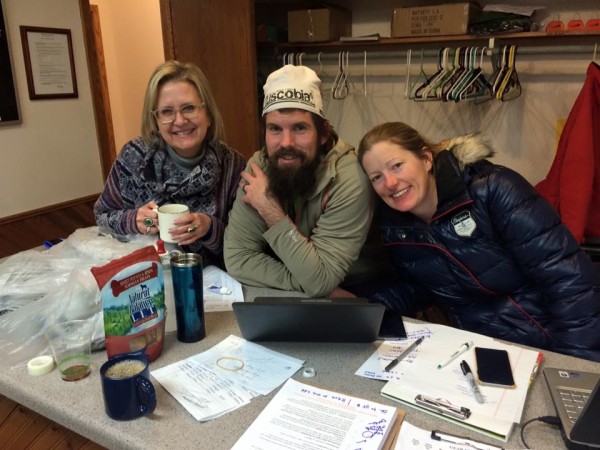
“We had great support from everyone in Rice Lake and are looking forward to even more integration with the local community in 2017,” noted race directors Helen (r) and Chris Scotch at the registration desk. With them, Janet Zastrow who runs the race timekeeping, acquires updates from the checkpoints and records the all-important finish.
As endurance athletes, appreciate the efforts of the race directors to secure the permits and passes necessary to stage the Tuscobia Winter Ultras every year. One must agree, Hulda would want that.
[write phillip@ultrasuperior.com]

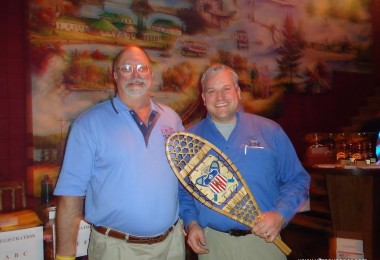
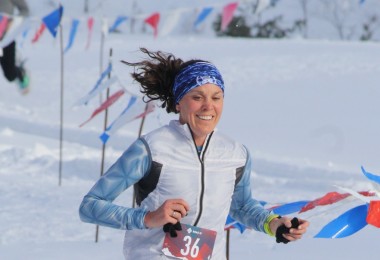
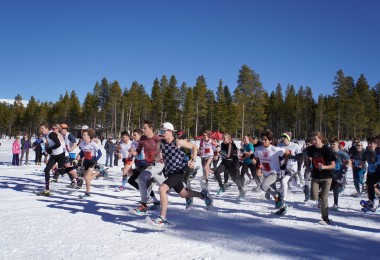
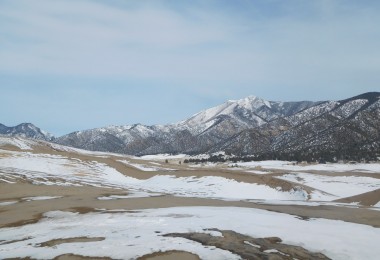

Leave a Comment